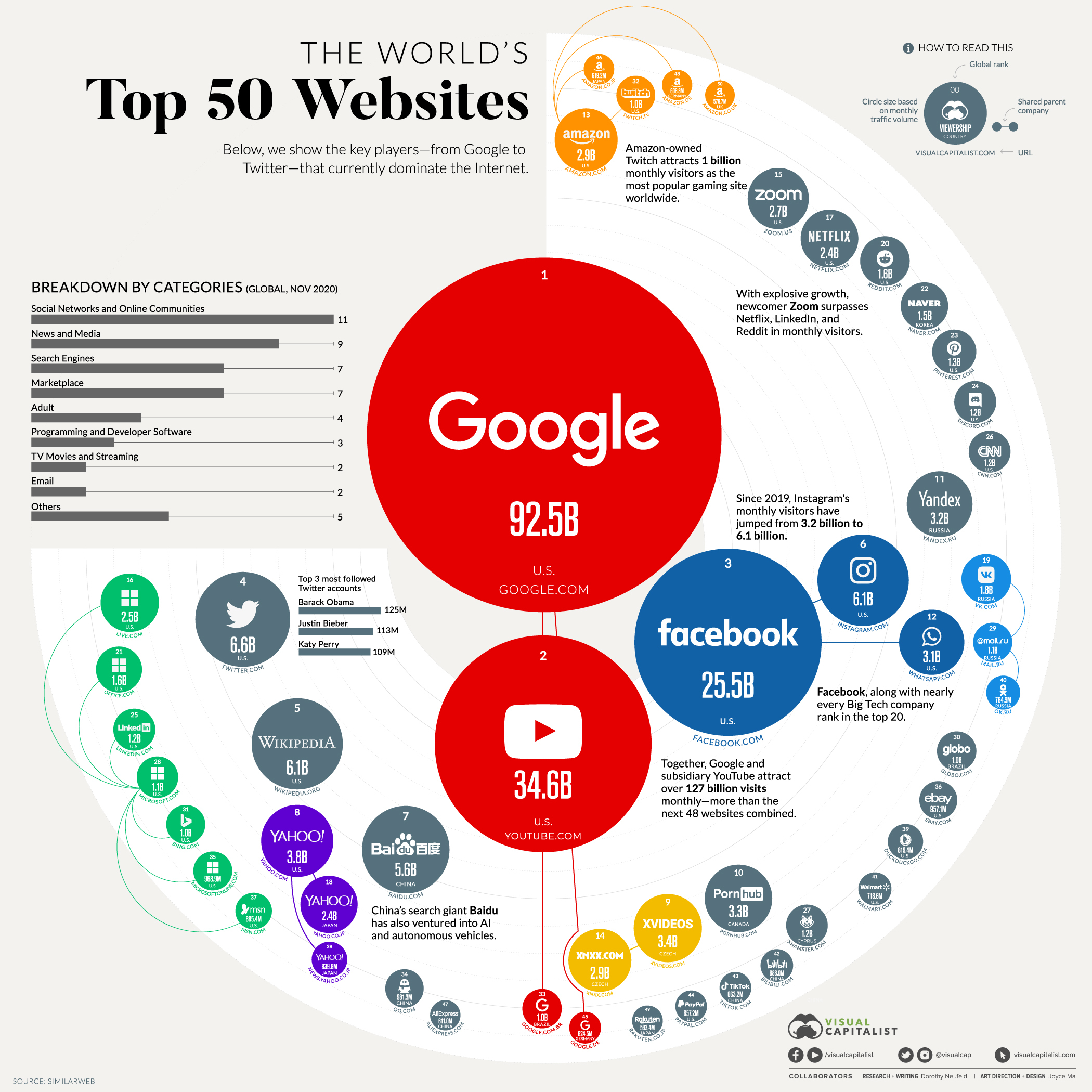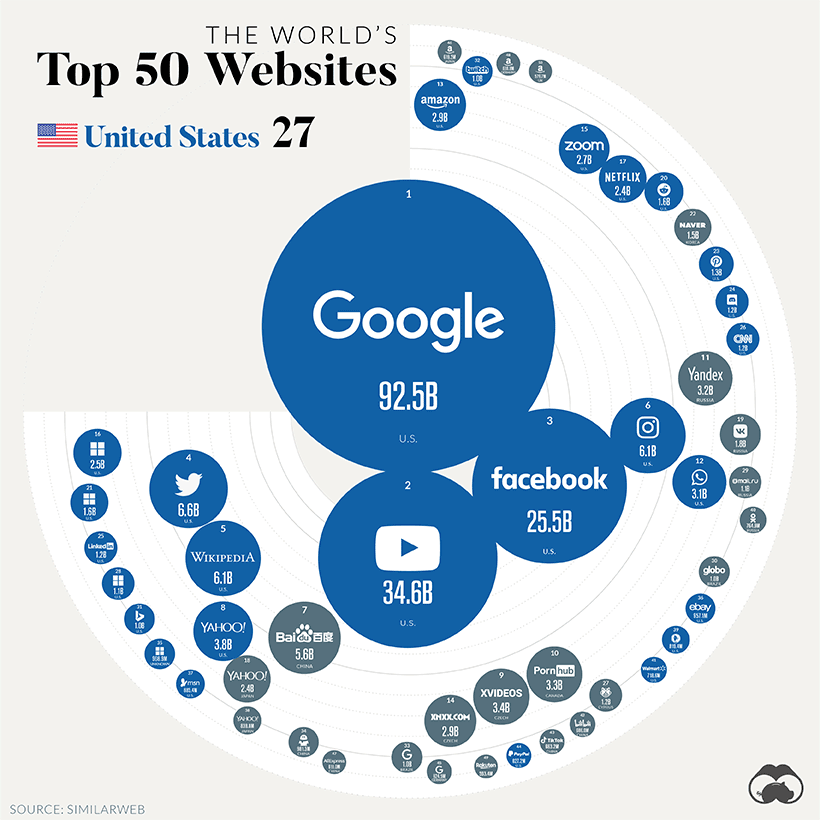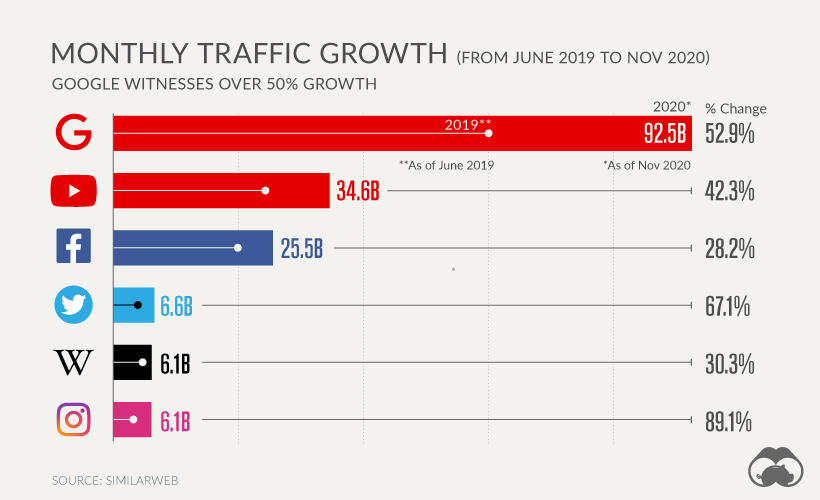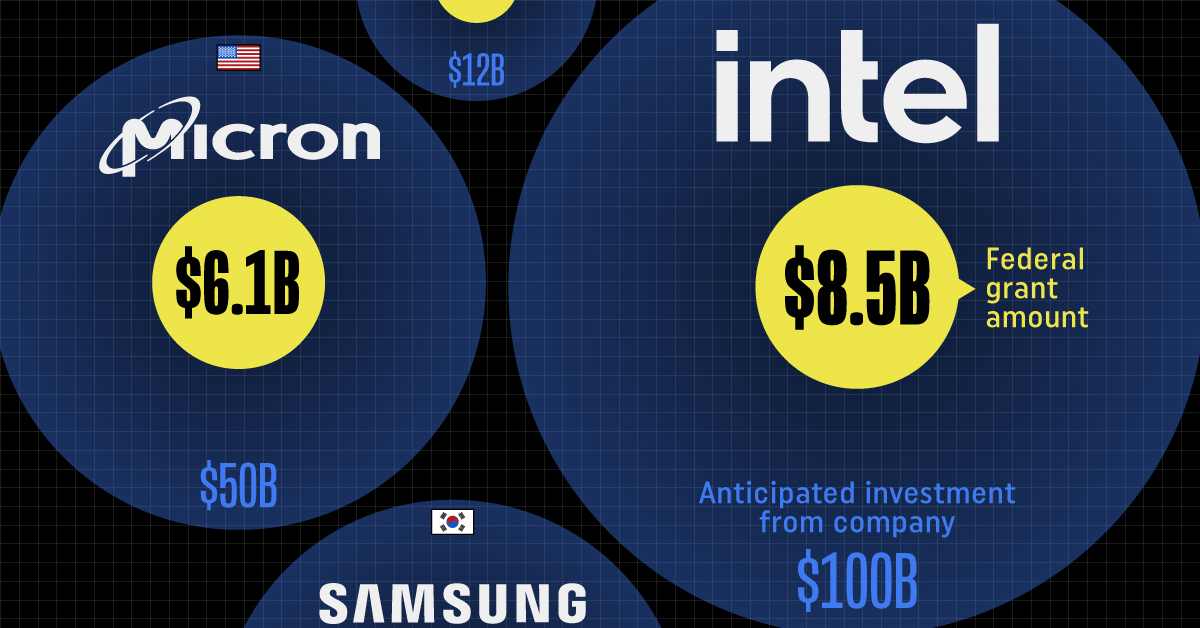Technology
The 50 Most Visited Websites in the World
View the full-resolution version of this infographic

The 50 Most Visited Websites In the World
View the high-resolution of the infographic by clicking here.
If you spend any time online, it’s likely you’re familiar with some of the world’s most visited websites. On today’s internet, a handful of giants have unmatched dominance.
Top Three Websites (Monthly visits):
- Google: 92.5 billion
- YouTube: 34.6 billion
- Facebook: 25.5 billion
Together, the top three websites rake in 152 billion visits monthly, outpacing the next 47 websites combined. What’s more, as the pandemic transformed everything from the way we work, learn, communicate, and shop—a majority of these activities migrated online.
In this new visualization, we look at the most visited websites around the world, drawing data from SimilarWeb (as of November 2020).
The Top Global Websites
Servicing over two trillion search queries annually through its network, Alphabet-owned Google ranks highest with its flagship domain, Google.com. Google derives approximately 80% of its earnings from ad revenues.
| Rank | Website | Monthly Visitors | Country of Origin | Category |
|---|---|---|---|---|
| 1 | Google.com | 92.5B | U.S. | Search Engines |
| 2 | Youtube.com | 34.6B | U.S. | TV Movies and Streaming |
| 3 | Facebook.com | 25.5B | U.S. | Social Networks and Online Communities |
| 4 | Twitter.com | 6.6B | U.S. | Social Networks and Online Communities |
| 5 | Wikipedia.org | 6.1B | U.S. | Dictionaries and Encyclopedias |
| 6 | Instagram.com | 6.1B | U.S. | Social Networks and Online Communities |
| 7 | Baidu.com | 5.6B | China | Search Engines |
| 8 | Yahoo.com | 3.8B | U.S. | News and Media |
| 9 | xvideos.com | 3.4B | Czech Republic | Adult |
| 10 | pornhub.com | 3.3B | Canada | Adult |
| 11 | Yandex.ru | 3.2B | Russia | Search Engines |
| 12 | Whatsapp.com | 3.1B | U.S. | Social Networks and Online Communities |
| 13 | Amazon.com | 2.9B | U.S. | Marketplace |
| 14 | xnxx.com | 2.9B | Czech Republic | Adult |
| 15 | Zoom.us | 2.7B | U.S. | Computers Electronics and Technology |
| 16 | Live.com | 2.5B | U.S. | |
| 17 | Netflix.com | 2.4B | U.S. | TV Movies and Streaming |
| 18 | Yahoo.co.jp | 2.4B | Japan | News and Media |
| 19 | Vk.com | 1.8B | Russia | Social Networks and Online Communities |
| 20 | Reddit.com | 1.6B | U.S. | Social Networks and Online Communities |
| 21 | Office.com | 1.6B | U.S. | Programming and Developer Software |
| 22 | Naver.com | 1.5B | South Korea | News and Media |
| 23 | Pinterest.com | 1.3B | U.S. | Social Networks and Online Communities |
| 24 | Discord.com | 1.2B | U.S. | Social Networks and Online Communities |
| 25 | Linkedin.com | 1.2B | U.S. | Social Networks and Online Communities |
| 26 | Cnn.com | 1.2B | U.S. | News and Media |
| 27 | xhamster.com | 1.2B | Cyprus | Adult |
| 28 | Microsoft.com | 1.1B | U.S. | Programming and Developer Software |
| 29 | Mail.ru | 1.1B | Russia | |
| 30 | Globo.com | 1.0B | Brazil | News and Media |
| 31 | Bing.com | 1.0B | U.S. | Search Engines |
| 32 | Twitch.tv | 1.0B | U.S. | Video Games Consoles and Accessories |
| 33 | Google.com.br | 1.0B | Brazil | Search Engines |
| 34 | QQ.com | 981.3M | China | News and Media |
| 35 | Microsoftonline.com | 968.9M | Unknown | Programming and Developer Software |
| 36 | ebay.com | 957.1M | U.S. | Marketplace |
| 37 | Msn.com | 885.4M | U.S. | News and Media |
| 38 | News.yahoo.co.jp | 839.8M | Japan | News and Media |
| 39 | Duckduckgo.com | 819.4M | U.S. | Search Engines |
| 40 | Ok.ru | 764.9M | Russia | Social Networks and Online Communities |
| 41 | Walmart.com | 718.6M | U.S. | Marketplace |
| 42 | Bilibili.com | 686.0M | China | Animation and Comics |
| 43 | Tiktok.com | 663.2M | China | Social Networks and Online Communities |
| 44 | Paypal.com | 657.2M | U.S. | Financial Planning and Management |
| 45 | Google.de | 624.5M | Germany | Search Engines |
| 46 | Amazon.co.jp | 619.2M | Japan | Marketplace |
| 47 | Aliexpress.com | 611.0M | China | Marketplace |
| 48 | Amazon.de | 608.8M | Germany | Marketplace |
| 49 | Rakuten.co.jp | 593.4M | Japan | Marketplace |
| 50 | Amazon.co.uk | 579.7M | United Kingdom | Marketplace |
Coming in second, social networking platform Facebook has a user base of 2.7 billion. On average, users spend 34 minutes on the site daily, while 36% of users say it’s also where they get their news—higher than any other social network.
As the leading search engine in China, Baidu (#7) received 5.6 billion visitors in November. Baidu is also branching out its business— venturing into electric vehicles (EVs) in a partnership with China-based automaker Geely.
As video conferencing vaulted in demand during the pandemic, Zoom (#15), launched into the most visited websites with 2.7 billion visitors monthly. Similarly, TikTok (#43) became a freshly minted addition.
The Most Visited Websites, By Country of Origin
With 27 sites on the list, the U.S. remains a dominant player. While its reach is highly concentrated on a global level, just a handful of companies own a majority of these sites.

See the static version of each regional graphic here.
Microsoft (#28), for instance, owns seven of the top sites in the world including LinkedIn (#25) and Live.com (#16). Amazon (#13), on the other hand owns five including Twitch.tv (#32), along with popular Amazon-focused domains in Japan, U.K., and Germany.
China holds five top websites: Baidu (#7), QQ (#34), Bilibili (#42), TikTok (#43), and AliExpress (#47). The Tencent-owned QQ.com, ranks as the top news site in China, with over 981 million monthly visits. Like WeChat, QQ also provides a popular messaging platform.
Just four of the most visited websites globally are based in both Russia and Japan, while the rest of the world account for 10 top sites altogether.
Reaching New Heights
While global internet patterns are clearly dominated by a few titans, what can we make of their recent traffic growth?
Between June 2019 and November 2020, Google’s monthly visitors increased 52.9%. Among the most visited websites globally, this rate of growth falls only behind Instagram (#6) at 89.1% and Twitter (#4) at 67.1%.

Wikipedia (#5), a non-profit website that originated in 2001 by Larry Sanger and Jimmy Wales realized over 30% growth.
While large tech companies have only accelerated their market share—Google makes up roughly 90% of the search ad market—several regulatory bodies are placing greater scrutiny on them. An October 2020 antitrust report suggested that Big Tech is in fact anti-competitive, drawing comparisons with oil tycoons of the 19th and 20th centuries.
With these key forces in mind, it raises a critical question: is there a limit to their growth?
Technology
All of the Grants Given by the U.S. CHIPS Act
Intel, TSMC, and more have received billions in subsidies from the U.S. CHIPS Act in 2024.

All of the Grants Given by the U.S. CHIPS Act
This was originally posted on our Voronoi app. Download the app for free on iOS or Android and discover incredible data-driven charts from a variety of trusted sources.
This visualization shows which companies are receiving grants from the U.S. CHIPS Act, as of April 25, 2024. The CHIPS Act is a federal statute signed into law by President Joe Biden that authorizes $280 billion in new funding to boost domestic research and manufacturing of semiconductors.
The grant amounts visualized in this graphic are intended to accelerate the production of semiconductor fabrication plants (fabs) across the United States.
Data and Company Highlights
The figures we used to create this graphic were collected from a variety of public news sources. The Semiconductor Industry Association (SIA) also maintains a tracker for CHIPS Act recipients, though at the time of writing it does not have the latest details for Micron.
| Company | Federal Grant Amount | Anticipated Investment From Company |
|---|---|---|
| 🇺🇸 Intel | $8,500,000,000 | $100,000,000,000 |
| 🇹🇼 TSMC | $6,600,000,000 | $65,000,000,000 |
| 🇰🇷 Samsung | $6,400,000,000 | $45,000,000,000 |
| 🇺🇸 Micron | $6,100,000,000 | $50,000,000,000 |
| 🇺🇸 GlobalFoundries | $1,500,000,000 | $12,000,000,000 |
| 🇺🇸 Microchip | $162,000,000 | N/A |
| 🇬🇧 BAE Systems | $35,000,000 | N/A |
BAE Systems was not included in the graphic due to size limitations
Intel’s Massive Plans
Intel is receiving the largest share of the pie, with $8.5 billion in grants (plus an additional $11 billion in government loans). This grant accounts for 22% of the CHIPS Act’s total subsidies for chip production.
From Intel’s side, the company is expected to invest $100 billion to construct new fabs in Arizona and Ohio, while modernizing and/or expanding existing fabs in Oregon and New Mexico. Intel could also claim another $25 billion in credits through the U.S. Treasury Department’s Investment Tax Credit.
TSMC Expands its U.S. Presence
TSMC, the world’s largest semiconductor foundry company, is receiving a hefty $6.6 billion to construct a new chip plant with three fabs in Arizona. The Taiwanese chipmaker is expected to invest $65 billion into the project.
The plant’s first fab will be up and running in the first half of 2025, leveraging 4 nm (nanometer) technology. According to TrendForce, the other fabs will produce chips on more advanced 3 nm and 2 nm processes.
The Latest Grant Goes to Micron
Micron, the only U.S.-based manufacturer of memory chips, is set to receive $6.1 billion in grants to support its plans of investing $50 billion through 2030. This investment will be used to construct new fabs in Idaho and New York.
-

 Education1 week ago
Education1 week agoHow Hard Is It to Get Into an Ivy League School?
-

 Technology2 weeks ago
Technology2 weeks agoRanked: Semiconductor Companies by Industry Revenue Share
-

 Markets2 weeks ago
Markets2 weeks agoRanked: The World’s Top Flight Routes, by Revenue
-

 Demographics2 weeks ago
Demographics2 weeks agoPopulation Projections: The World’s 6 Largest Countries in 2075
-

 Markets2 weeks ago
Markets2 weeks agoThe Top 10 States by Real GDP Growth in 2023
-

 Demographics2 weeks ago
Demographics2 weeks agoThe Smallest Gender Wage Gaps in OECD Countries
-

 Economy2 weeks ago
Economy2 weeks agoWhere U.S. Inflation Hit the Hardest in March 2024
-

 Environment2 weeks ago
Environment2 weeks agoTop Countries By Forest Growth Since 2001

















